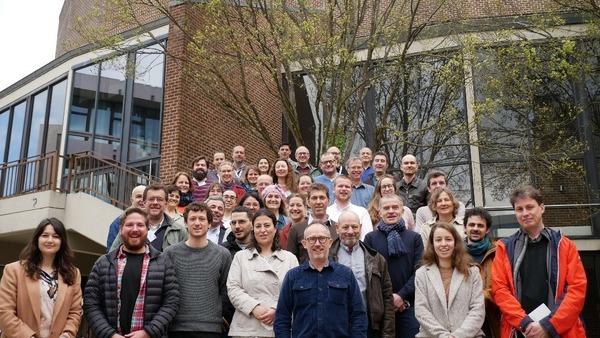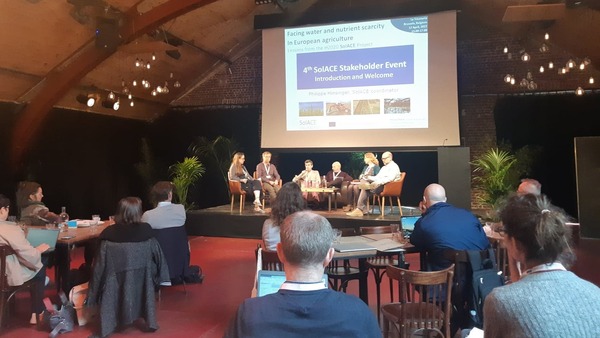SolACE was an ambitious, multi-actor project, gathering 25 European partners and funded for five years, starting in May 2017. A five-month extension was approved by the European Commission earlier this year, so SolACE was completed at the end of September 2022. Nevertheless, the Final Meeting took place in Belgium in April 2022. Here are a few highlights of this event and key lessons from SolACE.
Firstly, being a multi-actor project, SolACE has implemented various approaches to engage a broad range of stakeholders at all stages of project development. Several events were held to involve stakeholders, and Stakeholder Events were held at the Kick-Off Meeting in Montpellier in France (2017), the first annual meeting in Foggia in Italy (2018) and the meeting in Dundee, Scotland (2019). All these events were crucial steps to challenge our views with those of potential end-users of the knowledge produced.
However, since only a few stakeholders participated in these events, a special effort was made in the last project year to deepen the exchange with the stakeholders. Thus, five online pre-events were organised from January to April 2022, which ultimately registered a total of 276 participants, including 234 people who were not SolACE partners and represented a diversity of stakeholders. The results of the pre-events were presented at the final Stakeholder Event “Facing water and nutrient scarcity in European agriculture”, in April 2022 in Brussels, before the final annual meeting of SolACE. This successful, hybrid closing event was a unique opportunity to share the pros and cons of various multi-actor approaches with a wide range of stakeholders and to consider how to move forward based on the lessons learned from the SolACE project.
Data management plan and crop modelling was the first work package of SolACE. Throughout these five years, the “Handbook of Protocols and Methodology” was continuously updated to collect the approaches developed and used by SolACE partners. This was an essential prerequisite for developing the “Data Template” to collect data obtained by SolACE partners with harmonised formats. It is a constant challenge to ensure the partners use these standard documents and formats to share data, especially for the modelling efforts conducted in SolACE. The use of crop models for the three crops studied - bread wheat, durum wheat and potatoes - in combination with scenarios for a future climate in the different regions of Europe showed a wide diversity of crop responses. These include a substantial number of situations where positive effects of climate change (e.g. improved yield due to increased CO2 and temperature) can be expected, notwithstanding other potentially related stresses such as biotic stresses (e.g. climate change promoted emergence of pests or disease), which will possibly result in negative impacts of climate change.
Understanding crop and microbiome responses to combined water and nutrient limitations was the ambition of the SolACE work package 2. Water and nutrients being belowground resources, a large part of the effort was dedicated to analysing roots and their rhizosphere microbiome. To assess the genetic diversity of root traits, large panels of genotypes (about 250) were phenotyped in bread wheat and durum wheat, using high throughput phenotyping platforms. Furthermore, in wheat and potato, more in-depth investigations of the relationships between root traits and crop performance were conducted in smaller panels. In some of the experiments, microbiome characteristics were determined, focusing on mycorrhizal fungi in durum wheat. A significant diversity and plasticity of root traits were found, with different phenotyping environments leading to contrasting results. The role of deep rooting has emerged as an essential trait in relation to drought adaptation and deep nutrient acquisition. This work is ongoing through modelling with mechanistic models of root architecture in combination with reactive soil transport and crop models.
Assessing Novel agroecosystem management strategies and tools was the aim of the third work package of SolACE. Combinations of microbial inoculants and their formulation, crop rotations and genotype mixtures were the three types of innovations that were investigated in greenhouse conditions for their potential to alleviate drought and N or P stress before being further tested in field trials across Europe. Field trials were also designed to test other management practices and their potential combinations, such as zero or reduced tillage or the use of “Decision Support Systems”. Some of the field trials were conducted under organic farming conditions. The analysis of crop performance and relevant plant traits, as well as characteristics of the belowground microbiome, has shown contrasting effects of most of the tested innovations in the context of combined drought and N or P limitations. Among these, mixtures of durum wheat genotypes and combined microbial inoculants with appropriate formulation are promising, although their effect under field conditions was not always significant.
Designing and testing Novel breeding strategies and tools were the core tasks of work package 4 of SolACE. The phenotyping data collected on root systems enabled the application of quantitative genetics approaches and the development of genomic selection models, which were tested with quite a success against crop performance in the project’s final year for bread and durum wheat. On top of that, various technologies were implemented to design hybrids in bread wheat and potatoes that were then compared with their parents. While interesting crop performances were obtained in field-grown plants for bread wheat, the experimental hybrids produced so far for potatoes did not outcompete the commercial varieties. However, they indicate it is worth developing this technology further and testing it under a broader range of conditions. Another innovative approach was successfully implemented in durum wheat, based on an evolutionary population and a participatory approach with organic growers in Hungary and Italy, to use its large diversity and adapt it to local low input conditions.
Co-assessment of novel crop genotypes and management innovations in farmers’ networks was the ambitious goal of SolACE work package 5. Seven farmers’ networks have been established with more or less success in various European countries to represent a diversity of situations, both in terms of pedoclimatic conditions and farming systems, and to test combinations of management and breeding innovations developed in work packages 3 and 4. The farmers in the individual networks selected the innovations to be combined and tested. They also performed the trials and evaluated the performances of the crops in the various treatments. Unfortunately, the project’s time frame did not allow us to test all the innovations assessed in work packages 3 and 4. Therefore, only a part of the many potential combinations of innovations was tested, depending on the interest of the farmers in each network. These on-farm experiments showed contradictory results with inoculants and hybrids. Although farmers did not consider it as an innovation per se, the introduction of grain legumes in a crop rotation through life cycle analysis has been shown to be effective in reducing the carbon footprint of cereal crops and providing farmers with a better profit margin through lower costs.
Knowledge exchange and stakeholder engagement were at the heart of SolACE work package 6. In addition to organising SolACE Stakeholder Events, setting up the website, conducting interviews and sending out Newsletters were also intended to promote stakeholder engagement. Several stakeholders were also interviewed to help identify possible barriers (and potential enablers) adopting the innovations tested in SolACE. In addition, various dissemination materials were produced, including EIP-Agri Practice Abstracts, videos, training materials, publications in specialised and scientific press and communications at conferences. Furthermore, a series of policy briefs were published, providing key policy recommendations to address challenges.
Further information
- Youtube.com: Overview and key messages from the SolACE Project




 tap and then scroll down to the Add to Home Screen command.
tap and then scroll down to the Add to Home Screen command.
Disqus
In order to use the comment function, you must register with the third-party provider "Disqus".
When you activate this function, your browser establishes a direct connection with the servers of the third-party provider. We would like to point out that data is transmitted to the third-party provider after activation, and the latter may set cookies that can also be used for analysis and marketing purposes. For more information, please refer to our privacy policy.
Activate